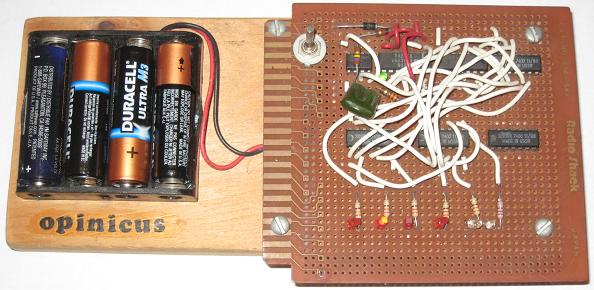Digital Memories
While hunting for my soldering iron, I found my first digital electronics project gathering dust in a box. I thought I’d thrown it out long ago, so I was happily surprised to see it. It’s not much to look at– just a 555 timer and a bunch of NAND gates wired to a row of LEDs, configured so that a single “blip” of light races up and down the row like Knight Rider’s front bumper. In fact Knight Rider was probably still on the air when I built this thing in the spring of 1991. I called it The Opinicus Blinker.

Opinicus was the name of a fake technology company I pretended to work for during high school, so that I could get into trade shows and scam real companies for product samples.
Sadly, The Blinker broke a long time ago, which is why I thought I’d tossed it out. I hoped maybe I could troubleshoot the problem and fix it, but after cleaning the battery contacts and installing a new set of batteries, it fired right up. Woohoo! There it is with the second LED from the left illuminated. Not bad for a 17 year old piece of junk. And check out the legend on those chips: “SOVTEK 7400 11/88, MADE IN USSR”. Wow.
The rate of progress on BMOW has been slowing, as I prepare to begin actual construction. Everything is pretty much ready to go, and there are just a few more parts I need. The last real hurdle is working out the physical layout of the machine: where to fit the chips on the board, where to fit the board in the case, how to connect power, and so on. I’ve decided to mount everything on a piece of wooden shelving for the time being, rather than build a real case. I didn’t want to get so hung up on case design that it distracted me from the main task of getting the CPU built and running.
Read 2 comments and join the conversation2 Comments so far
Leave a reply. For customer support issues, please use the Customer Support link instead of writing comments.


So the hardware design is relatively stable now? Perhaps a good time to start on an emulator so an OS can be written…
I don’t expect any more major hardware design changes. The only details still outstanding are related to extending the address space to 24 bits, and that’s basically done. I don’t think it would be too difficult to write a functional simulator that works at the microcode level, but it’s not high on my priority list at the moment. But if you or anyone else wants to attempt it now, I can give you any necessary details that I haven’t already mentioned here.